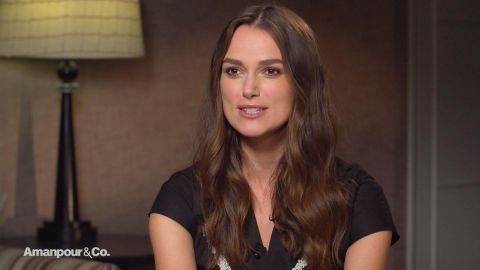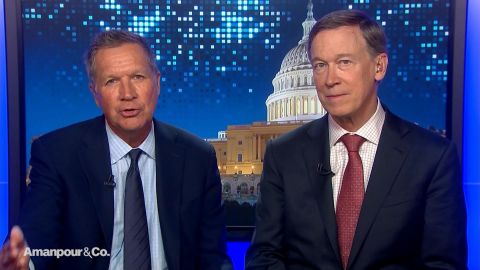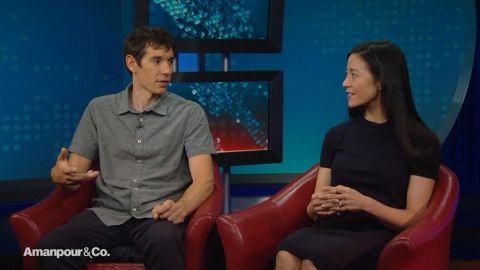Read Transcript EXPAND
HARI SREENIVASAN: So first of all, Alex, I think anybody watching this film is going to ask the question why no ropes. I understand that you practice with ropes but why take on a 3,000-foot granite wall with no safety net?
ALEX HONNOLD, FREE SOLO CLIMBER: I mean it’s kind of a complicated question but basically it’s just a subset of I guess special kind of challenge, a unique experience that you kind of have to seek out in that way.
SREENIVASAN: How do you train for something like this? I mean it took you almost four hours which is literally a marathon for most human beings and you’re talking about almost flat rock faces for hours at a time to keep your concentration going. So that’s kind of a physical training question and a mental training question.
HONNOLD: Yes. I mean I think I’ve pretty much split it up. So there’s the physical side of it which you can prepare just by climbing a route over and over with a rope and breaking it into pieces and memorizing the specific pieces and just sort of working on it. The psychological component is sort of the more open-ended, you know, I mean yes, it’s hard to know when you feel already, when you feel confident. A lot of it has to do with just how you feel, like this all confidence and that kind of stems from how physically prepared you are and how fit you feel. I mean they all — it both goes hand in hand but, you know, ultimately [13:45:00] they kind of have to come together at the same time and for a perfect execution.
SREENIVASAN: When you’re filming this, Chai, there’s a very real possibility — and you’ve discussed this in the film that something goes horribly wrong and you’re watching, not just a great climber, but who has become a friend to you in one of his last moments. I mean how do you grapple with that as a filmmaker?
ELIZABETH CHAI VASARHELYI, CO-DIRECTOR, FREE SOLO: Well, that was the central question while we were making the film. And while it was a possibility, we never — you know, we were rooting on Alex to be great and be just fine. But yes, from the very beginning, we had to — like my directing partner and I had to grapple with that question that could we — it was more like if we entered this to the cameras, are we going to affect his climbing and is he more likely to fall because we’re there than if he were alone.
And from that point, you know, yes, probably. We can definitely could be an interference. But, you know, Jimmy Chin who is my directing partner had this conversation with Jon Krakauer. And Jon, you know, laid it out pretty simply. He said, “One, is Alex going to free solo anyway?” Yes. “Is this something worth filming?” And absolutely, it was going to be one of the greatest human achievements ever. Like it was an incredible story. And “Are you guys the best to do it?” And that’s probably the case too. Just, you know, Jimmy has been filming and directing in the vertical world for 20 years.
SREENIVASAN: There’s a clip from the film is the boulder problem. It’s the section that you’re practicing. This is not the actual climb when you’re doing it. But you kind of lay this out and what you’re thinking about it and what you have to do. Let’s take a look.
(BEGIN VIDEO CLIP)
HONNOLD: And then reach out left to a big sloping. From there, either karate kick or double diner to an edge on the opposite wall. In some ways, it makes more sense to do the big two-handed jump because you’re jumping to a good edge so there’s actually something to catch. But the idea of jumping without a rope seems completely outrageous. If you miss it, that’s bad.
(END VIDEO CLIP)
SREENIVASAN: Alex, that’s not a hold. You’re talking about that’s the hardest hold. I mean you’re literally pushing your thumb into a rock and then doing something magical here. Who – it’s a hold.
HONNOLD: But that’s like the hardest part. I mean really it’s counter pressure. I mean the foothold you’re on is sort of reasonable so you’re driving up a foot and you’re using that little tiny upside down thing for balance to hold you into the wall. But I mean yes, that’s like the hard part.
SREENIVASAN: How long did it take to practice and practice and practice that until you felt confident enough?
HONNOLD: I mean I spent a year and a half sort of rehearsing that sections. You know, I had days where I’d hiked to some of El Cap and rappel down just to that part of the wall and then do it 10 or 12 times in a row and then rappel the rest of it to the ground. And then, you know, basically repeat that day in and day out until I felt comfortable.
VASARHELYI: Boulder problems are great example of how we compromised or worked on how to film this where for Alex, it was not so much the issue of whether or not he dies. And clearly, he doesn’t want to die but the idea of dying in front of his friends was complicated. So our compromise — and clearly we needed the boulder problem for the film you know.
I mean let’s just — I mean it’s interesting. It’s an interesting question, to begin with. So we needed the boulder problem for the film so the compromise was using remote control cameras. So there wasn’t a human there but there were cameras.
HONNOLD: Yes. And actually, it wasn’t a matter of just dying in front of friends. It’s also just knowing how stressed they would be watching and how distressed I would feel knowing that they’re stressed. I just didn’t want that near, that reflection of whatever they might be feeling because I knew that when I got to the boulder problem, I’ll have to sit for a moment and compose myself and tighten my shoes and sort of get ready. I knew that the whole time I’d be getting ready, my friend or whoever would be hanging there would be super, super stress because they would know like this is the moment. And I just didn’t want to feel that kind of pressure too, you know. Basically, I was like nobody should be there. The remote cameras were perfect compromise because that way, it’s great for the film but I didn’t feel anything.
SREENIVASAN: Chai, there’s also going to be people who were asking and looking at this guy and saying, “How is his brain different than ours?” And there’s a fascinating section of the film where you actually went into a fMRI scanner with him. Tell us a little bit about that.
VASARHELYI: So a journalist was writing an article about Alex. They wanted to look at Alex and it was a great opportunity for the film. And, you know, I think as you see in the film like there’s this — it takes more stimulation to trigger Alex’s blood than it does for the control subject. But my takeaway was that it was just extreme fear, like fear of therapy, that he’s been putting himself there for 10 years. And yes, it made him less tired. It’s not that he doesn’t feel fear, he definitely feels fear.
HONNOLD: Yes. If you’ve been desensitized over time. I mean that was my takeaway from the whole experience as well is that you know, I was like good thing they’re structurally at work so just requires a little more and that’s because I’ve been desensitized or 10 years of practice.
SREENIVASAN: So are you less scared? I mean when — what is the threshold where you get scared? On this climb, did you get scared?
HONNOLD: Not so much but I’ve been preparing for a year and a half. I mean, you know, I get scared if I think that I’m going to fall and die. And so had I been unprepared up there and felt like my feet are going to slip and fall, I mean I would have been just as scared as anybody. You know, perhaps more prepared to deal with it is because I’ve spent so much time up there. But, yes, I mean I don’t want to die any more than anybody else.
SREENIVASAN: So how do you get over that? If there’s a point where — even though you’ve done your preparations and you get to some point where it feels a little tricky, what is the process in your own mind to get yourself calm again?
HONNOLD: So I’ve had that experience on plenty of other (INAUDIBLE), not so much on El Cap because El Cap, I prepared so much. But on other times, yes, you get to very serious situations and you just have to sort of take a deep breath, compose yourself and just, you know, pull it together and perform.
SREENIVASAN: There’s a conversation that we’re able to witness in the audience inside your van. It’s a very personal conversation where your girlfriend is asking you basically like, “Do you take me into your equation?”
(BEGIN VIDEO CLIP)
CASSANDRA MCCANDLESS: Would putting me into the equation actually ever change anything? Would you actually make decisions differently?
HONNOLD: If I had some kind of obligation to maximize my lifespan, then like yes, obviously I’d have to give up soloing.
MCCANDLESS: With me asking you, do you see that as an obligation though?
HONNOLD: No, no.
(END VIDEO CLIP)
SREENIVASAN: As I was watching and I think a thousand other people are watching are like, “You’re going to lose the girl. You know, this is the wrong answer.”
HONNOLD: Yes. I mean I can’t really lie. And so I don’t know. I mean this — you know, I think that answer would maybe change over time. At that point, we had a conversation we’ve been dating maybe a year and I’ve been dreaming about free soloing El Cap or Seven at that point. And so I mean it was the most all-encompassing dream of my life. And, you know, I was dating this wonderful woman but you’re like, “Oh, it’s been a year, you know.” I mean it’s not the same weight as this big life dream that I’ve been carrying for so long.
SREENIVASAN: You remember the first thing you wanted to climb?
HONNOLD: Oh, I’m sure it’s not my crib and then the door fence in the house and then the trees in the backyard.
VASARHELYI: The roof is what I always heard about.
HONNOLD: Yes, that was early on too. But yes, I climb the buildings around my house, like some schools and churches and things. And just — and then went climbing gym and I started actually climbing for real.
SREENIVASAN: And what made you stick with it? Why did you — I mean —
HONNOLD: It’s so awesome. Have you not climbed? It’s so fun.
SREENIVASAN: Is there something that — I mean if it’s a climbing gym or someplace, I can see if you’re out there outdoor somewhere, this is spectacular, whatever. But what — before this interview, you went to work out. I mean this is what you do.
HONNOLD: Well, if you call it I went and played at the climbing gym, then that is way more fun. I mean, yes, that is working out. But basically, at the heart of it, I love the movement. I love swimming around. I love, you know, kicking my fear on and getting enough things and the problem-solving. It’s just it’s fun.
SREENIVASAN: The audience, they have — it’s almost like a feeling in your gut when you’re scared of you — watching you fall or watching you close to something. When you’re watching this, you know, how do you feel about the climbing versus the love story that’s also playing out in front of the audience?
HONNOLD: I mean when I’m watching the film, the climbing, I’m reliving some of the best days of my life. I mean the actual climb like that’s one of the best days my life and it’s all laid out. It’s beautiful. It’s, you know like that’s awesome. It’s almost like a journal every day for me. Watching my relationship laid out is a little bit more difficult.
SREENIVASAN: That’s harder for you to watch?
HONNOLD: Oh, yes, for sure. Yes, because I say so many things and I’m like, oh, I probably should have been a little bit kinder or said that a little bit more gently. Yes. Because when I watch all that, I’m like Sanni is such a great woman and I’m not that nice, you know. But yes, it’s hard to watch.
SREENIVASAN: It just opened in theaters. It’s doing really well. Why do you think it resonates to people who have no interest in rock climbing? I’ll ask you this as well.
VASARHELYI: One, we’re just incredibly grateful that people are going to see the movie. And I think it’s something different for everybody. I think that it’s just an incredible story about something that is you can’t even imagine and it’s supposed to be seen on a big screen because you’re right there next to him. I think that the love story is quite compelling and allows us as non-climbers to have access to what Alex is feeling. And part of me wonders if it’s also about seeing someone who has an audacious dream and actually, you know, achieves it. He does something, which I think in this moment in time, we’re not seeing very much of that.
SREENIVASAN: Alex Honnold, Chai Vasarhelyi, thanks so much for joining us.
HONNOLD: Yes. Thanks.
VASARHELYI: Thanks for having us.
About This Episode EXPAND
Christiane Amanpour interviews Governors John Kasich & John Hickenloooper and speaks with Keira Knightley. Hari Sreenivasan speaks with rock climber Alex Honnold and filmmaker Elizabeth Chai Vasarhelyi.
LEARN MORE


